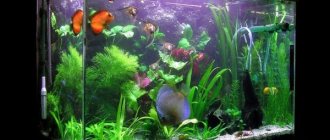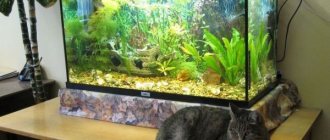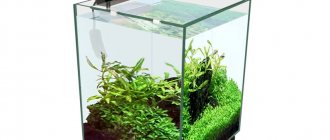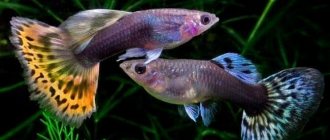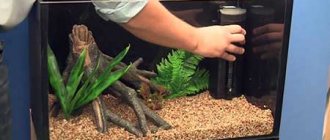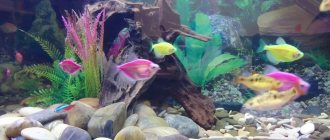Those who love aquarium farming know that there is no such thing as too much space in an aquarium. Pisces will never give up freedom and the opportunity to frolic. However, often the area on which the water house is supposed to be placed is limited. For example, you need to install it on the bedside table. Then comes a universal solution: a 30 liter aquarium .
This size assumes:
- specific design
- availability of mandatory equipment;
- suitable plants;
- reasoned number of inhabitants.
Where should I start?
The choice has been made, the purchase has taken place, the question arises: how to properly arrange a 30-liter aquarium?
There is no need to rush into releasing livestock. It is necessary to carefully prepare and create optimal conditions. They consist of:
- optimal lighting;
- aeration;
- water purification (filtration);
- maintaining temperature conditions;
- successful biocenosis (compatibility of selected plant species, snails, amphibians, fish and other biological organisms).
Selecting lighting for a 30-liter aquarium
Aquarium lighting in most cases occurs in two ways - natural light that penetrates the room during the day, and lamps that are installed near the aquarium or in the lid. Many people believe that it is enough to place the aquarium closer to the window and that will be enough, but this approach is completely wrong. Firstly, fish and plants will receive catastrophically little light through all obstacles: windows, curtains, aquarium glass, and the like. Secondly, the main meaning of the aquarium is lost - the aesthetic pleasure of contemplating the aquatic landscape and its inhabitants. Therefore, competent aquarists approach the issue of lighting carefully and pedantically, and resort to a variety of artificial light options. In a thirty-liter aquarium, we now have room to choose lamps and types of lighting, so we will try to carefully consider all the options.
A lamp for a 30 liter aquarium must have a reliable mount and create an optimal light flux. For this, incandescent lamps (ordinary household electric lamps), fluorescent or LED lamps can be used.
The power of incandescent lamps is determined at the rate of 1.2-1.5 watts per liter of volume. This lighting option is simple, but has a number of disadvantages: its luminous flux is clearly directed to one point, the water around this place gets very hot, and energy consumption is unreasonably high. The water in such an aquarium may begin to bloom, the walls become covered with a yellow (if there is a lack of light) or green (if there is an excess) coating. In aquariums equipped with electric lamps, blue-green algae and “blackbeard” are a frequent guest.
It is advantageous to equip an aquarium with a size of 30 liters with fluorescent lighting options (15-20 W will be sufficient power). Lamps can be daylight or have a certain yellowness. Their operating mechanism provides good light output, efficiency and the absence of a heating effect. The disadvantage is the mercury vapor included in the device. In the event of the smallest crack or split, they will enter the air of the room and create certain problems for human health.
The optimal and modern option for nanoaquariums is LED lamps. They are certainly more expensive, but they are economical, safe and effective.
In addition to the options described, today designers use low-power lamps that have colored shades. Thanks to them, fish scales shimmer, the greenery of plants becomes expressive, and corals and other design elements acquire a mysterious appearance.
For greater effect, place them on the bottom, along the line of intersection of the edges, behind the back wall.
Filter and aeration for a 30 liter aquarium
Constant water purification is an undoubted benefit. Modern filters purify water not from everything, but from pathogenic bacteria, dirt, rot from plants and food. Fish quickly get used to the fact that water flows are constantly moving, and do not experience the same stress as from constantly dragging a filter, which we can encounter in a ten-liter aquarium and in a twenty-liter aquarium. There are a great variety of filter models, and it is not difficult to choose the best option.
The filter operates under the pressure of the water mass. Therefore, it makes no difference what size the filter is: the main thing is that it supports the required power. For small aquarium devices, this power is optimal from 25 W to 40 W, although a device that is too powerful may work poorly and drive too strong flows of water.
The safety rules for the filter, regardless of its power, are the same:
- The filter should not be left turned off in the aquarium for a long time. If this does happen, or your lights have been turned off for a long time, you need to remove the filter from the aquarium and clean it properly.
- Do not put your hands into the aquarium while the filter is running. However, this applies to any electrical equipment that is directly related to the aquarium. In this way, you can get a discharge by carelessly jerking against the device, not particularly strong, but quite noticeable.
- The filter must not be allowed to remain exposed to air: it must be completely immersed in water, otherwise this will affect its performance.
- A filter that has been removed from the aquarium for a long time cannot be immediately put back: you need to first wash it or completely replace the filtration material in it.
- A newly purchased filter must be thoroughly washed so that the factory smell and accidentally introduced bacteria do not harm the fish.
You need to place the filter no closer than three to four centimeters from the bottom, and make sure that this gap remains constant, since water from the aquarium tends to evaporate, especially under intense lighting.
But at the same time, you need to follow the golden mean, and not leave the working parts of the filter in the air: the device must be completely covered with water. A non-functional or faulty filter must be immediately removed from the aquarium.
Life in a 30-liter aquarium, especially if these are not the smallest fish options, is full of problems. One of the main ones is a lack of oxygen, as a result of which the artificial microclimate suffers and:
- fish experience asphyxia;
- vegetation is dull in color and grows poorly;
- waste products of living beings do not decompose and create the preconditions for decay processes.
To avoid this, a thirty-liter aquarium must be equipped with an aerator (or compressor) to pump air. Today there are many options available for sale. Based on the existing canons (1 liter of water requires a power of 1 W/hour), a 30 W compressor would be a good option.
The device is installed outside the aquarium. The hose from it easily extends to the bottom and ends with a sprayer. Often, for an original design, it is hidden inside shells, in design objects, or simply in dense thickets of plants. This gives the inner world originality and similarity to the depths of the sea.
The disadvantage of such compressors is a humming sound during operation, especially for devices of significant power. Many of them have a power switch control. You can switch it yourself during the day.
You will also need to install a heater (for cold periods) and a thermometer to monitor the water temperature.
Heater settings
A good choice is a heater that fits comfortably into the aquarium. To heat a large volume of water, it is recommended to use two devices. There is no need to pre-prepare the heater; you can only wipe it with a damp cloth before immersing it in water. You can also check it for any violations in the integrity of the shell.
To install the heater, you just need to attach it with Velcro to the glass. It is advisable to choose a place where there is a good flow of water and the least visibility. After this you can turn it on. The recommended temperature for a regular aquarium is 23−27 degrees Celsius. A light will usually light up while the heating element is active - this will help with the heating cycling process.
What kind of soil is needed for a 30 liter aquarium?
Depends on what you are growing. If there are no plants expected, then it does not matter. And the best and most universal soil for plants (based on my experience) is coarse river sand with a fraction of 3-5 mm. As a rule, everything grows in it.
It also depends on what kind of fish you will keep, i.e. if there are a lot of sand-burrowing fish (for example catfish), you don’t need it to be too small, for obvious reasons, so that there is no eternal turbidity. For many large cechlids, they need stones, and more of them; these animals love to start construction projects and can destroy all the soil at random. .
Which soil is definitely not needed:
- painted Chinese rubbish with glass. Not only does it release all sorts of crap into the water, but the fish can be injured.
- limestone, it greatly increases the hardness of the water, this is bad for many fish and plants, check the soil - drop vinegar on it, if it doesn’t hiss, you can put it in the aquarium.
- contaminated with oil waste and gasoline cannot be washed off with anything.
Let's populate the living creatures
1) Day one - four
The water may become cloudy. This should not scare you: at this time the microclimate of the aquarium is being formed and your intervention may disrupt the existing ecology of the aquarium;
2) Day four - fifth
We plant our first plants in the aquarium. It is advisable to select plants that are the most undemanding in terms of water parameters. For example: nayas, hornwort, vallisneria, riccia, hygrophila, ambulia.
3) Day nine-ten
You can turn on the lighting. We do this for a certain time, approximately 9-10 hours a day. At the same time, we take out and clean the filter: after ten days it has become quite dirty and needs thorough cleaning. (A tip for cleaning the filter from experienced aquarists is when you clean and rinse it, fill a separate container with your aquarium water and rinse the filter only in this water). Introduce the first inhabitants into a new aquarium: for example, a flock of swordtails. Watch the fish for a day, but don't feed them (don't worry, they won't die).
4) Day eleven
We feed the fish. Since your fish didn’t eat anything yesterday, today we give them a little food. If you give them a lot of food, they may develop stomach problems. The fish are fed twice a day with small portions of bloodworms. Continue to monitor the state of life in the aquarium.
5) Day seventeen-twentieth
If you see that everything is fine and your fish are cheerful and active, then the ecosystem and microclimate have been established, and you can continue to populate your aquarium. But first, you need to change approximately 10-15% of the water, clean the glass, and clean the filter again. Depending on the size of the aquarium, you can continue to populate it, but it is important to know: overpopulation is the enemy of not only the fish themselves, but also the entire ecosystem in principle. Remember the unspoken but important rule: for 1 fish, up to 5 centimeters in size, you need 2-3 liters of water. Take this into account and decide who and how many you can put in the aquarium. Don't forget about snails, the snail is an important component of the aquarium ecosystem, it is a natural laboratory for processing organic waste!
6) Day twenty-fifth
We clean the soil, change the water - 15% of the volume
The aquarium is fully operational: now it has its own climate and is working!
Plants for aquarium 30 liters
Plants are needed for natural filtration and to create shade for secretive fish. Greens are involved in many biological processes taking place in a body of water, for example, absorbing carbon dioxide or harmful inorganic compounds. Beautiful and unpretentious plants:
- Elodea;
- Cryptocoryne;
- Java moss;
- Hornwort;
- Heteranthera doubtful;
- Yakut.
Main nuances
Creating an aquarium is a complex process that requires responsibility from the aquarist. Already at the initial stage, it is necessary to resolve several issues that will help determine the style, design and inhabitants of the reservoir. For beginners in aquarium farming, there are instructions, following which you can take the first successful steps to start an aquarium.
Preparing to properly start the aquarium:
- You need to start by determining the types and number of fish that will live in the tank. Before moving in, they will find out details about the content of phenotypes, the requirements of the fish and the compatibility of the selected varieties.
- The second step is to determine the capacity of the reservoir. The volume is selected based on the size and number of future pets. The best option is a 20-liter aquarium, but there are also larger options, for example, a 150-liter aquarium.
- Taking into account the needs of the fish, equipment for the tank is purchased: lighting lamps, filter, heater, aerator.
- For an artificial pond, choose a place where the aquarium will be located. The place should be secluded and quiet; sunlight should not penetrate into the container with fish.
- To install the tank, purchase a durable cabinet. To start a large aquarium, you will need a flat, stable bedside table that can withstand heavy loads. You can also place an aquarium according to Feng Shui.
- The purchased container is washed without the use of hazardous chemicals. To be on the safe side, you can boil the tank to avoid bacterial infections.
Before starting an aquarium, you need to correctly select and process decorative components, plants and assemble equipment.
Selecting fish for a 30 liter aquarium
So who should be accommodated and how many?
You can often find nano aquariums stocked with shrimp (shrimp fish) or frogs. It's exotic, but doesn't fit the description of a classic water house.
The easiest places to start are guppies and swordtails. These fish get along well with each other and do not require too much water. 30 liters can accommodate 10 guppies or 3 pairs of swordtails. The recommendations are similar for mollies and gourami.
They would be cozy for a pair of goldfish or a flock of neon babies.
A separate conversation about scalars. Pisces leading a “standing” lifestyle do not like active movements around them. Therefore, launch them no more than five or six, and alone.
Lovers of platies and Odessa barbs will not be pleased with this volume of water. It can provide a normal life for only three individuals. But danios, cardinals or tetras can be safely populated by six.
Feel free to launch up to 12 neons and ornathuses, and twenty guppies. There can be only two Corydoratus speckled catfishes.
It is convenient to introduce cleaners, such as catfish. By picking up leftover food from the bottom, they naturally sanitize the soil and water. In addition, they are fun and interesting to watch, as if talking and attracting attention.
Having decided which fish are suitable for a 30-liter aquarium, you should design it taking into account their biological characteristics. Each participant in the emerging biocenosis has the right to healthy living conditions and active activity.
What is important when choosing a filter?
The water in the aquarium is constantly becoming polluted. These include the remains of obsolete plants, fish excrement, and pathogenic bacteria, which, if live food was used, could get inside. Of course, you can change all the water once a week, wash the soil and rinse the plants. But, firstly, in the case of a volume of 30 liters it is difficult. Secondly, constantly catching fish can lead to injury to them.
In order not to endanger the fish, as well as to eliminate the toxic effects of polluting components, a suitable filter is necessary. Which one can suit a 30L water house? The one whose power is determined by the manufacturer to be within 40 W.
It is advisable to determine the exact figure taking into account the set of planned fish. It is necessary to be guided by their needs in the volume of water driven.
The operation of any filter requires attention and caution. It is important to comply with:
- electrical safety rules;
- regular cleaning;
- complete immersion of the device in water;
- placing it in the aquarium at a certain distance from the bottom (usually 3-4 centimeters).
If the aquarium filter has been pulled out or there has been a power outage, you should install it back and put it back into operation only after it has been completely cleaned. This is necessary to prevent contaminants from flowing back into the water.
Aquarium content
In addition to starting the aquarium, an important detail is the care and maintenance of the aquarium.
For cleaning you will need:
- net for catching fish;
- siphon for soil cleaning;
- glass scraper.
Weekly maintenance of the aquarium takes place in 4 stages:
- soil siphon;
- quarter water change;
- equipment washing;
- cleaning glass from plaque.
Get a second aquarium for quarantine, fish spawning and a nursery for the young. Another spacious container will do. After purchasing a fish, do not immediately place your new neighbor in a common aquarium. Keep your new pet in a quarantine container for several weeks. If the fish does not show signs of illness, you can add it to the others. Neglecting quarantine puts the lives of the inhabitants of the reservoir at risk, because most diseases are introduced with new fish. Sick fish are also kept in a quarantine tank where they undergo treatment.
About microclimate parameters
Even a novice aquarist who strives to carefully care for his hobby knows that water temperature is an important component of a prosperous life. In addition to filtration, a thirty-liter aquarium must have a heating element and a thermometer.
The fact is that even in the life of the same fish, at certain stages it is necessary to raise or lower the temperature (for example, during the spawning period). It is known that the higher the temperature, the faster the fish grow, but they also end their life cycles faster. With the help of regulators this can be done with sufficient accuracy.
Some general tips to help you avoid mistakes.
- For an aquarium with entry-level equipment, without well-growing live plants, the volume of water required to successfully keep fish must be doubled.
- If the aquarium does not have any filtering equipment, then it must be equipped with a good lamp, a powerful compressor and a high-quality heater. There should be no less than half the area of the bottom of the aquarium with live plants.
- But in any case, an aquarium with the simplest so-called entry-level equipment must additionally include an internal filter. The filter material must be cleaned at least once a week so that an overloaded filter does not begin to release harmful dirt concentrate back into the water.
- An aquarium that already has an advanced version of equipment must additionally have a powerful external filter. The external filter should be cleaned at least once a month.
- The population density of the aquarium is given solely based on the water actually available in the aquarium, that is, it does not include the total volume of the aquarium, soil, stones, decorations, filters and everything else.
- When purchasing a new resident, you need to calculate the landing rate taking into account the size of the adult.
(Visited 816 times, 1 visits today)
Why infuse water and when to add fish?
Only flooded water is absolutely not suitable for the life of underwater inhabitants. It must be left for at least 1 day. During this time, chlorine will evaporate from the liquid, and heavy metals will settle to the bottom. After 2-4 days it should become cloudy - this indicates the proliferation of a colony of beneficial bacteria (the so-called nitrogen cycle). First, they oxidize ammonia, which releases nitrites (they are toxic and dangerous). Then bacteria appear in the water, converting nitrites into nitrates (they are harmful if there is an excess, in other cases they serve to feed plants).
This process may take up to 2-3 weeks. You cannot plant fish at this time. At the final stage of starting the aquarium, according to the step-by-step instructions, it is recommended to throw a starter with beneficial bacteria or squeeze out of the filter inside. You can ask your friends for the latter; it will help establish a suitable environment.
Vegetation
If you are creating an aquarium from scratch, then before planting flowers it is necessary for the water to sit for 2-3 days. If the owner does not have time, then there are a couple of methods on how to quickly start an aquarium. It is necessary to wait time to establish a balance that is created independently with the help of bacteria. To quickly start an aquarium, owners add special preparations containing beneficial bacteria to start the aquarium.
Stages of balance formation:
- The appearance and proliferation of bacteria leads to cloudiness of the water.
- After 3-4 days, the liquid will return to normal, becoming colorless.
- Bacteria begin to work, forming a microclimate.
After allowing the balance to normalize on its own, or by adding medications, you can move on to selecting and planting plants. Before starting the aquarium, underwater flowers are disinfected as follows:
- A weak solution of potassium permanganate of a pale pink hue is prepared.
- Plants are immersed in the solution, leaving for 15 minutes.
Plants are planted in the tank according to their height: low-growing flowers are placed in the foreground, tall and medium-sized flowers are placed in the background. Root species of flora are planted in the ground in the usual way, but some varieties require additional fixation.
The following representatives of the flora will help create the correct microclimate:
- Winged carrots.
- Rostifolia.
- Fast growing grass.
- Liverwort mosses and ferns.
We come up with a design and place decorative elements
Decoration, driftwood in the aquarium.
You can come up with the decor yourself or copy it. Its main elements, which are found in almost all aquariums, are stones and driftwood. You can buy stones or find beautiful natural ones. They are first checked with vinegar. If a reaction occurs, they are no good. They can only be used with plants and fish that like hard water. Disinfection is carried out by boiling in water.
The second element of aquarium decor is driftwood. They are found in every natural body of water. If placed in an artificial one, it creates a natural environment that is beneficial to the inhabitants.
You can buy driftwood, including from exotic trees. Can also be found in nature. Any type of tree is suitable, except conifers. The most durable ones are made from willow and oak.
The snag needs to be prepared. The bark is removed from it, the rot is removed, and then it must be boiled. This operation destroys all spores, bacteria, insects and other unwanted inhabitants. The cooking process removes various substances from wood.
The operation is also necessary to ensure that the snag does not float up. To do this, boil it in water with salt: 300 g per 1 liter. Cook for up to 10 hours, adding water. If a snag is found under water, there is no need to add salt - it will already sink. Wooden decor from the store is also boiled in water without salt for 6 hours.
The boiled driftwood is placed in cold water and observed to see if it becomes colored. If it's a little, that's okay. When tannins are released abundantly, the wood is soaked.
The snag is placed so that it does not rest against the opposite walls. The tree will swell, expand in size, and may squeeze out the glass.
Keep in mind that some fish like to hide in secluded places. They are given this opportunity by dropping some suitable thing to the bottom. It should not be made of plastic, rubber, or have sharp edges.
Background
Background for an aquarium.
Aqua designers believe that the best background is a black or dark blue film on the back wall. They highlight the beauty of fish and plants, the picture is constantly changing. The photo background looks unnatural and boring.
For some reason, most people try to fix the background from the inside, whereas you can do it from the outside and not be afraid that it will fall off. In the same way, instead of film, you can stretch dark fabric to fit the size of the back wall.
For modern decor, you should take a closer look at 3D backgrounds that look voluminous and deep. You may come across the opinion that the fish do not like it and it disorients them. Then there is another option - a volumetric background 3-20 cm thick made of foam or silicone. It imitates the relief of the underwater world.

